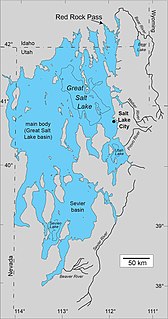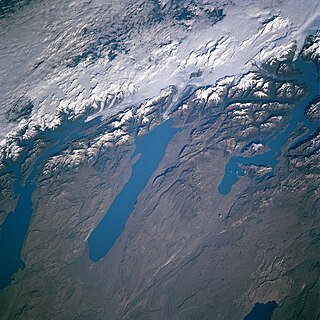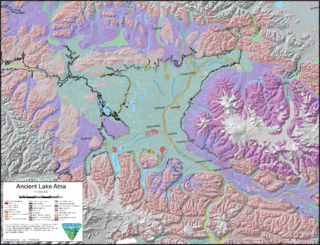Related Research Articles

The Pleistocene is the geological epoch that lasted from about 2,580,000 to 11,700 years ago, spanning the Earth's most recent period of repeated glaciations. Before a change finally confirmed in 2009 by the International Union of Geological Sciences, the cutoff of the Pleistocene and the preceding Pliocene was regarded as being 1.806 million years Before Present (BP). Publications from earlier years may use either definition of the period. The end of the Pleistocene corresponds with the end of the last glacial period and also with the end of the Paleolithic age used in archaeology. The name is a combination of Ancient Greek πλεῖστος, pleīstos, 'most' and καινός, kainós, 'new'.

Lake Bonneville was the largest Late Pleistocene paleolake in the Great Basin of western North America. It was a pluvial lake that formed in response to an increase in precipitation and a decrease in evaporation as a result of cooler temperatures. The lake covered much of what is now western Utah and at its highest level extended into present-day Idaho and Nevada. Many other hydrographically closed basins in the Great Basin contained expanded lakes during the Late Pleistocene, including Lake Lahontan in northwestern Nevada.

The Last Glacial Period (LGP), also known colloquially as the last ice age or simply ice age, occurred from the end of the Eemian to the end of the Younger Dryas, encompassing the period c. 115,000 – c. 11,700 years ago. The LGP is part of a larger sequence of glacial and interglacial periods known as the Quaternary glaciation which started around 2,588,000 years ago and is ongoing. The definition of the Quaternary as beginning 2.58 million years ago (Mya) is based on the formation of the Arctic ice cap. The Antarctic ice sheet began to form earlier, at about 34 Mya, in the mid-Cenozoic. The term Late Cenozoic Ice Age is used to include this early phase.
Tollmann's bolide hypothesis is a hypothesis presented by Austrian palaeontologist Edith Kristan-Tollmann and geologist Alexander Tollmann in 1994. The hypothesis postulates that one or several bolides struck the Earth around 7640 ± 200 years BCe, with a much smaller one approximately 3150 ± 200 BCE. The hypothesis tries to explain early Holocene extinctions and possibly legends of the Universal Deluge.

In geology, a proglacial lake is a lake formed either by the damming action of a moraine during the retreat of a melting glacier, a glacial ice dam, or by meltwater trapped against an ice sheet due to isostatic depression of the crust around the ice. At the end of the last ice age about 10,000 years ago, large proglacial lakes were a widespread feature in the northern hemisphere.
The Bytham River was one of the great Pleistocene rivers of central and eastern England until it was destroyed by the advancing ice sheets of the Anglian Glaciation around 450,000 years ago. It is named after Castle Bytham in Lincolnshire. Its catchment area included Worcestershire, Warwickshire, Oxfordshire and Derbyshire, and it flowed eastward across East Anglia to the North Sea.

There have been five or six major ice ages in the history of Earth over the past 3 billion years. The Late Cenozoic Ice Age began 34 million years ago, its latest phase being the Quaternary glaciation, in progress since 2.58 million years ago.

The Anglian Stage is the name used in the British Isles for a middle Pleistocene glaciation. It precedes the Hoxnian Stage and follows the Cromerian Stage in the British Isles. The Anglian Stage is correlated to Marine Isotope Stage 12, which started about 478,000 years ago and ended about 424,000 years ago.
The Hoxnian Stage was a middle Pleistocene stage of the geological history of the British Isles. It was an interglacial which preceded the Wolstonian Stage and followed the Anglian Stage. It is equivalent to Marine Isotope Stage 11. Marine Isotope Stage 11 started 424,000 years ago and ended 374,000 years ago. The Hoxnian is divided into sub-stages Ho I to Ho IV.
The Wolstonian Stage is a middle Pleistocene stage of the geological history of Earth from approximately 374,000 until 130,000 years ago. It precedes the Eemian Stage in Europe and follows the Hoxnian Stage in the British Isles.
The Illinoian Stage is the name used by Quaternary geologists in North America to designate the period c.191,000 to c.130,000 years ago, during the middle Pleistocene, when sediments comprising the Illinoian Glacial Lobe were deposited. It precedes the Sangamonian Stage and follows the Pre-Illinoian Stage in North America. The Illinoian Stage is defined as the period of geologic time during which the glacial tills and outwash, which comprise the bulk of the Glasford Formation, accumulated to create the Illinoian Glacial Lobe. It occurs at about the same time as the penultimate glacial period.
The Yarmouthian stage and the Yarmouth Interglacial were part of a now obsolete geologic timescale of the early Quaternary of North America.

The Quaternary glaciation, also known as the Pleistocene glaciation, is an alternating series of glacial and interglacial periods during the Quaternary period that began 2.58 Ma and is ongoing. Although geologists describe the entire time period up to the present as an "ice age", in popular culture the term "ice age" is usually associated with just the most recent glacial period during the Pleistocene or the Pleistocene epoch in general. Since planet Earth still has ice sheets, geologists consider the Quaternary glaciation to be ongoing, with the Earth now experiencing an interglacial period.
Lake Lapworth was a postulated glacial lake in Great Britain, believed to have formed during the last ice age when glaciers ended the northern outlet of the Severn. This ran through the Dee. At some point or points it ran into glaciers and backed up to form a resultant lake. This overflowed southwards cutting the Ironbridge Gorge, near Telford in Shropshire. This permanently diverted most of the Severn drainage basin to its current basin which flows south.

Pymmes Brook is located in North London and named after William Pymme, a local land owner. It is a minor tributary of the River Lea. The brook mostly flows through urban areas and is particularly prone to flooding in its lower reaches. To alleviate the problem the brook has been culverted in many areas. Part of it is a Site of Borough Importance for Nature Conservation, Grade II.
The Pre-Illinoian Stage is used by Quaternary geologists for the early and middle Pleistocene glacial and interglacial periods of geologic time in North America from ~2.5–0.2 Ma.

The Shonkin Sag is a prehistoric fluvioglacial landform located along the northern edge of the Highwood Mountains in the state of Montana in the United States. The Sag is a river channel formed by the Missouri River and glacial meltwater pouring from Glacial Lake Great Falls. It is one of the most famous prehistoric meltwater channels in the world.

Lake Atna was a prehistoric proglacial lake that initially formed approximately 58 ka in the Copper River Basin, an area roughly centered around 245 km (152 mi) northeast of modern-day Anchorage, Alaska. The lake formed, and dispersed, during the Wisconsin glaciation. The lake existed in several forms, with several prominent shorelines observable in modern geology. At its greatest extent, the lake surface area was approximately half the size of modern-day Lake Ontario, and possibly much larger. The basin of the lake lay within an area bordered by the Alaska Range to the north, the Wrangell Mountains to the east, the Chugach Mountains to the south, and the Talkeetna Mountains to the west.

Lake Alamosa is a former lake in Colorado. It existed from the Pliocene to the middle Pleistocene in the San Luis Valley, fed by glacial meltwater from surrounding mountain ranges. Water levels waxed and waned with the glacial stages until at highstand the lake reached an elevation of 2,335 meters (7,661 ft) and probably a surface of over 4,000 square kilometers (1,500 sq mi), but only sparse remains of the former waterbody are visible today. The existence of the lake was postulated in the early 19th century and eventually proven in the early 20th century.
References
- Citations
- ↑ Waugh 2000, p. 122.
- ↑ Harrison 1898.
- ↑ Harrison 1898, p. 407.
- ↑ Shotton 1953.
- ↑ Shotton 1953, p. 246.
- ↑ "The BGS Lexicon of Named Rock Units: Warwickshire Group". British Geological Society. Retrieved 1 November 2021.
- ↑ Harwood 1987, pp. 115–6.
- ↑ Harwood 1988, pp. 145–7.
- ↑ Coope 1994, p. 423.
- ↑ Shotton 1983.
- ↑ Radley 2009, p. 83.
- ↑ Murton & Murton 2012, p. 124.
- ↑ Little 1984, p. 34.
- ↑ Shotton 1983, p. 274.
- ↑ Coope 1994, p. 422.
- Bibliography
- Coope, G. R. (February 1994). "Frederick William Shotton, 8 October 1906 – 21 July 1990". Biographical Memoirs of Fellows of the Royal Society. 39.
- Harrison, W. Jerome (August 1898). "The ancient glaciers of the Midland counties of England". Proceedings of the Geologists' Association. 15 (9).
- Harwood, Doug (1987). "Teaching Controversy by Seminar: an example in Quaternary geomorphology". Journal of Geography in Higher Education. 11 (2). doi:10.1080/03098268708709002.
- Harwood, Doug (July 1988). "Was there a glacial Lake Harrison?" (PDF). The Mercian Geologist. 11 (3).
- Little, John Antony (1984). Engineering properties of glacial tills in the Vale of St. Albans (PDF) (D. Phil. thesis).
- Murton, Della K.; Murton, Julian B. (2012). "Middle and Late Pleistocene glacial lakes of lowland Britain and the southern North Sea Basin". Quaternary International (260).
- Radley, Jonathan D. (2009). "The Geological Evolution of Warwickshire" (PDF). The Mercian Geologist. 17 (2).
- Shotton, F. W. (7 July 1953). "The Pleistocene deposits of the area between Coventry, Rugby and Leamington and their bearing upon the topographic development of the Midlands". Philosophical Transactions of the Royal Society of London: Series B. Biological Sciences. 237 (646). doi:10.1098/rstb.1953.0004.
- Shotton, F. W. (1983). "The Wolstonian stage of the British Pleistocene in and around its type area of the English Midlands". Quaternary Science Reviews. 2 (4).
- Waugh, David (2000). Geography: an Integrated Approach. Nelson Thornes. ISBN 9780174447061.